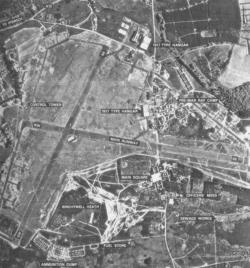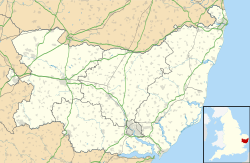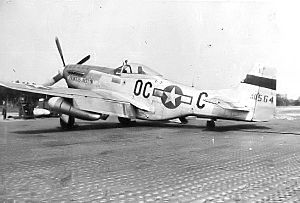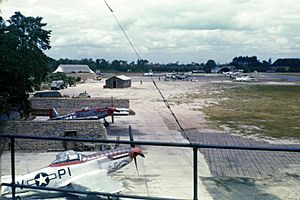RAF Martlesham Heath facts for kids
Quick facts for kids RAF Martlesham HeathUSAAF Station 369 |
|||||||||
|---|---|---|---|---|---|---|---|---|---|
| Woodbridge, Suffolk in England | |||||||||

Martlesham Heath Airfield - 9 July 1946
|
|||||||||
|
Shown within Suffolk
|
|||||||||
| Coordinates | 52°03′29″N 1°15′58″E / 52.058°N 1.266°E | ||||||||
| Type | Royal Air Force station | ||||||||
| Code | MH | ||||||||
| Site information | |||||||||
| Owner | Air Ministry | ||||||||
| Operator | Royal Flying Corps Royal Air Force United States Army Air Forces |
||||||||
| Controlled by | RAF Fighter Command 1939-43 Eighth Air Force |
||||||||
| Site history | |||||||||
| Built | 1917 | ||||||||
| In use | January 1917 - 1963 | ||||||||
| Battles/wars | First World War European theatre of World War II Cold War |
||||||||
| Airfield information | |||||||||
| Elevation | 27 metres (89 ft) AMSL | ||||||||
|
|||||||||
RAF Martlesham Heath was an important air base in England. It was located near Woodbridge in Suffolk. This base was active for many years, from 1917 to 1963. It played a big role in developing new radar technology for planes. The base was used by both British and American air forces.
Contents
History of RAF Martlesham Heath
Early Days: World War I and Testing Aircraft
Martlesham Heath first became an airfield during World War I. This was in 1917. It was used by the Royal Flying Corps, which was the UK's air force at the time.
A special unit moved here to test new airplanes. This unit was called the Aeroplane Experimental Unit. Over time, its name changed to the Aeroplane and Armament Experimental Establishment (A&AEE). This group tested many aircraft and weapons. These tests helped prepare for World War II.
RAF Fighter Command in World War II
When World War II started in 1939, the A&AEE moved away. Martlesham Heath then became a key base for RAF Fighter Command. This was the part of the Royal Air Force that defended Britain.
Many famous planes flew from here. These included Bristol Blenheim bombers, Hawker Hurricanes, Supermarine Spitfires, and Hawker Typhoons. Famous pilots like Robert Stanford Tuck and Douglas Bader were based here.
Battle of Britain Attacks
During the Battle of Britain, the airfield was attacked by German planes. On August 15, 1940, nearly 40 German planes bombed and shot at the base. The damage was extensive and took a full day to fix.
Another attack happened on October 27, 1940. About 40 Messerschmitt Bf 109 fighter-bombers attacked. Anti-aircraft guns fired at them. This helped to reduce the damage to the airfield.
- No. 71 (Eagle) Squadron was based here in 1941. This squadron was made up of American volunteers.
- An Air Sea Rescue Flight also operated from Martlesham Heath. They helped rescue pilots who crashed into the sea.
American Air Force Use
In 1943, Martlesham Heath was chosen for use by the United States Army Air Forces (USAAF). It was given the special name "Station 369."
The 356th Fighter Group
The 356th Fighter Group arrived at Martlesham Heath in October 1943. They were part of the Eighth Air Force. Their planes had a special magenta and blue diamond pattern on the front.
The group had three main squadrons:
- 359th Fighter Squadron
- 360th Fighter Squadron
- 361st Fighter Squadron
They flew Republic P-47 Thunderbolt planes at first. In November 1944, they switched to North American P-51 Mustangs.
The 356th Fighter Group flew many missions. They protected bombers attacking targets in Europe. They also bombed and shot at enemy targets on the ground. These targets included U-boat bases, airfields, and railway yards.
They helped a lot during Operation Market-Garden in September 1944. This was a big airborne attack in the Netherlands. The group received a special award for their efforts. Their last combat mission was on May 7, 1945. They helped drop propaganda leaflets. The group returned to the USA and was closed down in November 1945.
After the War: RAF and Closure
After the American forces left, the airfield went back to the RAF. In the years after the war, RAF Fighter Command squadrons were based here. However, the runways were not long enough for new jet planes. In 1955, the main runway was made longer.
Special units continued to use the base for testing. The Bomb Ballistics and Blind Landing Unit moved in. This unit later became the Armament and Instrument Experimental Unit (A&IEU). It stayed at Martlesham until 1957.
The airfield was kept in reserve for a few years. An Air Sea Rescue helicopter unit was also based here. By the end of 1960, most units had left. The Battle of Britain Memorial Flight was here from 1958 to 1961. After this, the airfield was mostly empty. The Air Ministry officially closed the base on April 25, 1963.
Current Use of the Site
Today, Martlesham Heath is no longer a military base. It has become a modern area with businesses and homes. The old hangars and buildings are now used for light industry and storage.
A memorial stands on the old parade ground. It honors the members of the 356th Fighter Group who died in World War II. The main police headquarters for Suffolk is also located on part of the old airfield.
The original control tower from the airfield is still there. It has been turned into a museum. In July 2017, a special stone was revealed. It was placed on the village green to remember the base's history. During this event, a Hurricane and Spitfire plane flew over the crowd.

See also
- List of former Royal Air Force stations
- Adastral Park science campus
- Prince Obolensky






